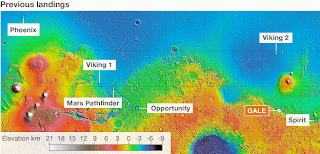 |
| Orbital view of the north polar region of Mars |
There is a fascinating aspect of Mars which we rather rushed over in the second part of A Trip Around Mars, now on BBC World Service. This post seeks to address the issue. It's about the periodic melting of the water ice in its north polar regions and the growth of glaciers elsewhere, every few million years.
In the programme, it cropped up towards the end with Chris McKay of NASA's Ames Research Center. He was the principal investigator on the Phoenix lander mission which went to the far North in 2008.
Chris mentioned how the occasional warming of the permafrost just under the high northern plains might create a "muddy mix" of dirt and water in which Martian microbes might persist - if they exist. My editing of the show left out the mechanism for the warming and melting.
Wayward Tilting
It turns out that the angle at which Mars' north and south poles tilt changes dramatically over a period of several million years. The Earth's axis of rotation remains at an angle of about 24 degrees; it is stabilised over time by the presence of our Moon. Mars lacks this stabilising influence, meaning there are times when its north polar region tilts right over and becomes significantly more exposed to the Sun's radiation each year. Ice warms, melts and/or sublimes into the atmosphere.
Greg Crater and its Young Glaciers
We heard another fascinating story about Mars connected with this. It concerns a crater called Greg. Greg is 66 kilometres across, lies in the middling latitudes of the southern hemisphere (east of the Hellas basin) and was named after a Victorian romantic and proto-science fiction writer. Most remarkable are what look like glaciers on the inner slopes of its northern rim.
The story of Greg's glaciers was told to us by another of our interviewees, the eminent planetary geologist and astronomical painter, Bill Hartmann of the Planetary Science Institute, University of Arizona.
 |
| Kevin Fong and Bill Hartmann |
Here is an audio clip of Bill describing the initial discovery and the appearance of the glaciers on the northern slopes of the crater, and 'glacial' landforms in southern parts of the crater.
This image shows the tongue-shaped glaciers in more detail. My understanding is that white ice is not exposed at the surface in these structures. They have a covering of regular red-brown Mars dust and rock.
The next image shows the unusual landforms around the crater's south inner wall.
Bill Hartmann's count of small craters that have hit the glaciers since their formation suggests they are extremely recent in Martian geological history. As he says, between 5 and 20 million years.
How could you get ice accumulating and then flowing as glaciers so recently in this region of Mars? Answers emerged from a collaboration with scientists in France, including global climate modeller Francois Forget. Forget took his computer climate model and plugged in the Red planet's parameters instead of terrestrial ones - Martian gravity, atmospheric pressures and composition, Martian topography et cetera. Then they used the computer models to estimate climate variation around Mars at various tilts of the planet's north-south axis. Bill Hartmann takes up the story in this next clip.
To sum it up: a few million years ago, Mars was tilted over more extremely than today. Ice in the north evaporated and sublimed into the atmosphere. The model suggests it was most likely to snow out and accumulate as ice in Greg crater's region of Mars.
Radar Evidence for Ice Flows in the Greg Neighbourhood
Greg's glaciers are too small for existing orbiters with ground-penetrating radar to confirm that they are made of ice. But not so far away, there are larger landforms that are. Here's Bill again plus an image showing an ice apron around a mountain, in the general 'neighbourhood of Greg.
Bill Hartmann thinks this fascinating story has a lesson for us here on Earth - particularly for certain brands of politicians and commentators who pour scorn on anthropogenic climate change and global climate modellers.
Ice on Canvas - Bill Hartmann's Latest Astronomical Painting
Science aside but continuing the ice theme, Bill showed us one of his astronomical paintings in progress - a view of Saturn from one of its ice moons, Enceladus (if my memory is correct).
























